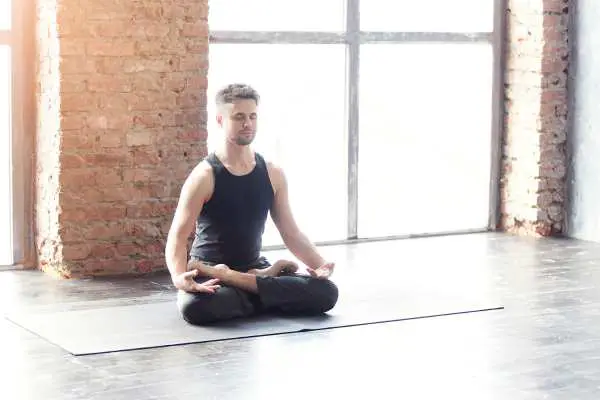Hey there, fellow meditators and curious minds! Are you interested in learning Transcendental Meditation (TM), but feeling unsure about whether or not you need a teacher? Well, you’ve come to the right place!
In this article, we’ll explore the question of whether you can do TM without a teacher and provide you with all the juicy details you need to make an informed decision.
First off, let’s start by defining what TM is all about. This form of meditation has gained quite a bit of popularity in recent years, thanks in part to its endorsement by celebrities like Oprah Winfrey and David Lynch.
But what exactly is TM? Essentially, it’s a technique that originated in the ancient Vedic tradition of India and involves the use of a mantra to help the practitioner achieve a state of deep relaxation and inner peace.
Now, you might be wondering if you need a teacher to learn this technique. And the answer is… Yes, it is possible to learn and practice Transcendental Meditation without a teacher, but it may pose certain risks and challenges that can be mitigated by seeking guidance from a qualified instructor.
So, let’s dive deeper into the pros and cons of each approach.
But first, let’s address the elephant in the room – can you really trust yourself to meditate without guidance? Well, I hate to break it to you, but your mind is a tricky little bugger that loves to play tricks on you.
Just when you think you’ve achieved inner peace, it’ll throw a monkey wrench into the mix and you’ll find yourself wondering if you left the stove on. So, keep that in mind as we explore your options for learning TM without a teacher.

What is Transcendental Meditation?
Let’s start by defining what Transcendental Meditation (TM) is and where it comes from. TM is a technique of meditation that originated in the ancient Vedic tradition of India.
The Vedic tradition is one of the oldest and most comprehensive systems of knowledge in the world, and it includes practices such as yoga, meditation, and Ayurveda.
So how does one practice TM? The technique involves sitting comfortably with eyes closed and using a mantra, which is a sound or word that is repeated silently.
The mantra is carefully selected by a trained TM teacher based on the individual’s personal characteristics and needs.
During the practice of TM, the repetition of the mantra helps to quiet the mind and settle the body. As one becomes more relaxed, the mind naturally transcends to a state of pure awareness, beyond thought and sensory experience.
This state is often described as a deep inner silence or a state of pure consciousness.
There are many benefits to practicing TM. For starters, it’s been shown to be a highly effective tool for stress reduction, which is no small feat in today’s fast-paced world.
Studies have also shown that TM can improve focus and creativity, as well as increase overall well-being.
In fact, research on TM has shown that it can have a wide range of positive effects on both physical and mental health. For example, studies have found that TM can lower blood pressure, reduce symptoms of anxiety and depression, and even improve cognitive function.
All in all, TM is a powerful practice with a long history and a lot of research to back it up. But can you do it without a teacher? That’s the big question we’ll be tackling next.
Can You Do Transcendental Meditation Yourself?
If you’re eager to try Transcendental Meditation (TM) but don’t have access to a certified teacher, you might be wondering if you can learn the technique on your own.
While there are resources available online, books, and even mobile apps that claim to teach TM, there are some things you should consider before embarking on this journey solo.
One of the main advantages of learning TM on your own is the convenience factor. You can learn and practice the technique in the comfort of your own home, at a time that suits you, and at your own pace.
This can be especially appealing for those with busy schedules or limited access to a certified TM teacher.
However, there are also some drawbacks to learning TM on your own. First and foremost, you won’t have the guidance and personalized instruction that a certified TM teacher can provide.
This means that you might not be able to fully understand or appreciate the subtleties of the technique, and you may struggle to get the full benefits.
Additionally, TM is a subtle practice that involves the use of a specific mantra and a delicate process of transcending.
It can be easy to misunderstand or misinterpret these elements, especially without the feedback and correction of a teacher.
In fact, some people who attempt to learn TM on their own end up practicing a different form of meditation entirely.
Aside from the risk of not fully benefiting from the practice, there are some potential risks of practicing TM without proper guidance. For example, using the wrong mantra or practicing incorrectly could lead to frustration or even exacerbate existing stress and anxiety.
Additionally, the process of transcending in TM can sometimes bring up unexpected or uncomfortable emotions or experiences.
A trained teacher can help you navigate these experiences and provide you with support and guidance along the way.
That being said, there are some success stories of people who have learned TM on their own and achieved significant benefits. However, these cases are relatively rare, and many people who attempt to learn TM without a teacher end up giving up or practicing incorrectly.
Ultimately, if you’re serious about practicing TM and reaping its full benefits, it’s highly recommended that you seek out a certified teacher.
This will ensure that you learn the technique correctly, receive personalized instruction and support, and can fully enjoy the positive effects of the practice.

Why do some people prefer to learn TM from a teacher?
While it’s true that some people have successfully learned Transcendental Meditation on their own, many others choose to learn from a qualified teacher.
There are a number of benefits to this approach that are worth considering.
- One of the primary benefits of learning TM from a teacher is personalized instruction. Every person is different, and a good teacher can help tailor the technique to suit the individual needs of each student.
This can involve adjusting the length of the meditation sessions, selecting an appropriate mantra, and providing guidance on how to deepen the practice over time.
- Another advantage of learning from a teacher is ongoing support. Meditation is a skill that takes time and practice to develop, and having a teacher to provide guidance and encouragement along the way can be incredibly helpful.
A good teacher can answer questions, provide feedback, and offer support during challenging times, helping students stay motivated and committed to their practice.
- Additionally, a TM teacher can play an important role in helping students overcome challenges and deepen their practice. Learning to meditate can be a transformative experience, but it can also be challenging at times.
A good teacher can help students navigate these challenges and provide guidance on how to move forward.
There are also some common misconceptions about TM teachers and their qualifications. Some people believe that anyone can teach TM, or that it’s not necessary to receive formal training to become a teacher.
However, the truth is that becoming a certified TM teacher involves a rigorous training program that typically takes several months to complete. TM teachers are trained to provide safe and effective instruction, and they receive ongoing support and supervision to ensure that they are maintaining the highest standards of teaching.
Overall, while it is possible to learn Transcendental Meditation on your own, many people choose to learn from a qualified teacher in order to receive personalized instruction, ongoing support, and guidance in deepening their practice.
What are the Advantages and Disadvantages of Doing TM Yourself?
Transcendental Meditation (TM) is a powerful tool that can help you reduce stress, improve focus, and increase your overall well-being. While some people prefer to learn TM from a qualified teacher, others choose to teach themselves.
In this section, we’ll explore the advantages and disadvantages of doing TM yourself.
Advantages of Self-Teaching
One of the main advantages of self-teaching is the greater flexibility it offers. When you teach yourself, you can choose when and where you want to practice, without having to worry about scheduling conflicts or travel time.
Additionally, self-teaching is often more affordable, since you don’t have to pay for the services of a qualified teacher.
Self-teaching can also be empowering, as it allows you to take control of your own learning and progress at your own pace. You can explore different resources and techniques, and find what works best for you.
This can be especially valuable for people who have busy schedules or live in areas where there are no qualified TM teachers available.
Potential Disadvantages of Self-Teaching
One of the biggest risks of self-teaching is the lack of guidance. TM is a complex practice that requires proper technique and guidance to achieve maximum benefits.
Without a qualified teacher, you may not be able to achieve the full benefits of TM, or even worse, you may risk harming yourself by using improper techniques.
Another disadvantage of self-teaching is the risk of developing bad habits. If you don’t have a teacher to guide you, it’s easy to fall into patterns of improper technique or not dedicating enough time to your practice.
This can prevent you from experiencing the full benefits of TM.
Tips and Techniques for Practicing TM without a Teacher
If you choose to teach yourself TM, there are several tips and techniques you can follow to ensure that you are practicing correctly and safely.
- First, be sure to find high-quality resources, such as books or online courses, that have been reviewed by experts in TM. These resources can guide you through the proper technique and help you understand the process of transcending.
- It’s also important to build a community of support. This can be done by connecting with other TM practitioners through online forums or social media groups. These communities can offer support, advice, and motivation to help you stay on track with your practice.
- Finally, be patient with yourself. TM is a lifelong practice, and it takes time and dedication to achieve the full benefits. If you’re struggling, don’t hesitate to reach out to other practitioners or seek guidance from a qualified teacher.
They can help you overcome any challenges and deepen your practice.
In conclusion, self-teaching TM can be a viable option for those who cannot access a qualified teacher.
However, it’s important to weigh the advantages and disadvantages carefully and take steps to ensure that you are practicing correctly and safely. With the right resources and support, self-teaching can be a rewarding and fulfilling experience.

Common challenges people face when learning TM on their own
While self-teaching TM can be a viable option for some, there are some common challenges that people may encounter along the way.
- One of the biggest challenges is staying motivated and consistent with the practice. Without the guidance of a teacher, it can be easy to fall out of the routine or become discouraged.
- Another challenge is managing distractions during meditation. It’s common for the mind to wander during meditation, and without a teacher to guide you, it can be difficult to bring your focus back to your mantra.
Fortunately, there are strategies you can use to overcome these challenges and build a sustainable TM practice on your own.
- One approach is to schedule a regular meditation time each day, preferably in the morning or evening, and stick to it as much as possible.
- It’s also helpful to create a peaceful environment free from distractions, such as turning off your phone and finding a quiet place to meditate.
- Another strategy is to find a community of support, whether it’s online or in-person. There are many resources available for people learning TM on their own, such as forums, blogs, and social media groups, where you can connect with others and share your experiences.
By taking these steps, you can successfully navigate the challenges of self-teaching and build a sustainable TM practice that brings you the benefits of reduced stress, improved focus and creativity, and increased well-being.
Many people have successfully learned and practiced TM on their own, and you can too with the right mindset and support.
Conclusion
In conclusion, we have discussed the advantages and disadvantages of learning Transcendental Meditation without a teacher.
While self-teaching can offer flexibility and cost savings, it also comes with the risk of improper technique and lack of guidance. It is important to consider the potential risks and benefits and make an informed decision based on personal needs and circumstances.
We have also explored the benefits of learning TM from a qualified teacher, including personalized instruction and ongoing support.
Teachers can help students overcome challenges and deepen their practice. However, it is important to address common misconceptions about TM teachers and their qualifications.
For those considering learning TM on their own, we have offered practical tips and techniques for establishing a regular practice, managing thoughts and emotions during meditation, and finding a community of support. It is important to acknowledge the common challenges of self-teaching and develop strategies for staying motivated and consistent.
In summary, whether to learn TM with or without a teacher is a personal decision. It is important to explore all options and find the best fit for individual needs and circumstances.
With the right approach and support, anyone can establish a sustainable and fulfilling TM practice.

Frequently Asked Questions
Can I learn TM online?
Yes, there are online TM courses available for those who prefer to learn TM remotely. However, it’s important to make sure you’re learning from a qualified TM teacher who can provide personalized instruction and support.
Look for courses offered by certified TM organizations, and make sure the teacher is trained and authorized to teach TM. It’s also worth noting that in-person instruction may provide additional benefits, such as the ability to ask questions and receive immediate feedback.
How do I find my mantra?
In TM, a specific sound or mantra is used to help the mind settle and transcend. The mantra is given to you by a qualified TM teacher during a personalized instruction session. It is not recommended to try to find or choose your own mantra, as each mantra is specifically chosen based on your individual needs and characteristics.
It is important to learn TM from a qualified teacher to receive proper guidance and instruction in the technique, including the use of a specific mantra.
How long does it take to learn TM?
Typically, the initial TM course consists of four sessions, each lasting about 1-2 hours. Once you have learned the technique, it is important to establish a daily practice, ideally meditating for 20 minutes twice a day.
The length of time it takes to learn TM and establish a regular practice may vary depending on the individual’s dedication and commitment to the practice.











